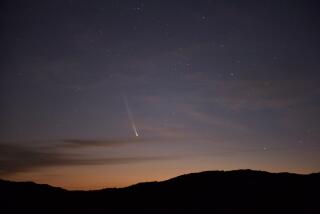The State - News from Feb. 11, 1986
- Share via
Solar flares and weather problems have delayed for two weeks a close-up image of Halley’s comet at its closest approach to the sun, the National Aeronautics and Space Administration said. The photographic image produced from an ultraviolet light spectrograph aboard the Pioneer Venus orbiter spacecraft was to be released today at NASA’s Ames Research Center in Mountain View. However, space agency spokesman Peter Waller said scientists have been unable to assemble the image because of difficulties caused by the largest solar flares in a year, which interfered with the data transmitted from Pioneer. Snow at a receiving station in Madrid and rain at another station in California’s Mojave Desert also interfered with the data transmission, Waller said.
More to Read
Sign up for Essential California
The most important California stories and recommendations in your inbox every morning.
You may occasionally receive promotional content from the Los Angeles Times.










